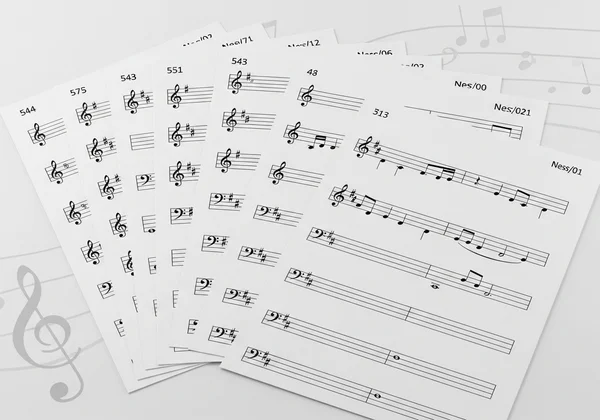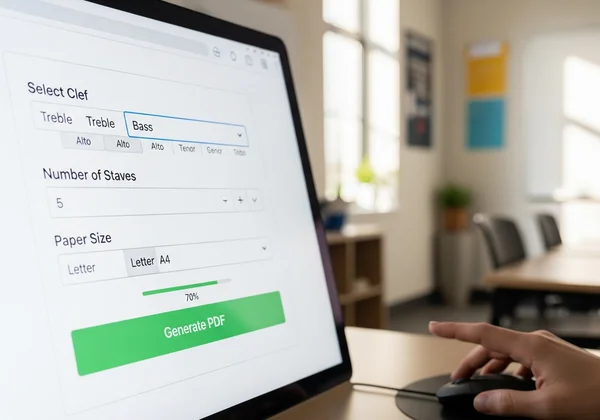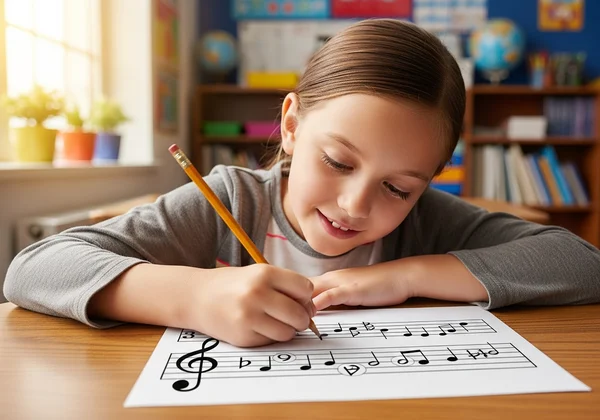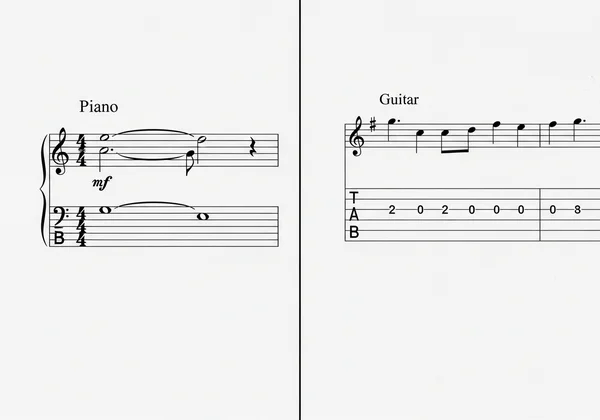Printable Staff Paper Exercises for Music Teachers
Music teachers, are you tired of constantly searching for engaging, printable resources that actually inspire your students? Finding high-quality, versatile, and budget-friendly materials often feels like a full-time job. With limited prep time and diverse student needs, you need a powerful, yet simple, solution. Imagine having an unlimited supply of printable staff paper, perfectly tailored for any lesson, from basic note recognition to advanced composition, all available for free.
This is where our platform becomes your most valuable teaching assistant. We provide a complete toolkit of free, customizable, and ready-to-use staff paper that will save you time, spark your students' creativity, and elevate your classroom activities. Let's explore how you can transform your lessons with these essential resources.

Why Printable Music Worksheets Are Essential for Your Classroom
The modern music classroom demands flexibility. Pre-printed workbooks are often rigid and expensive, while digital-only solutions can exclude hands-on learning. Printable music worksheets bridge this gap perfectly, offering a dynamic and cost-effective way to support your curriculum. They are more than just paper; they are a canvas for musical exploration and a cornerstone of effective pedagogy. When you need a specific clef, a certain number of staves, or paper for a particular instrument, a quick visit to our online tool is all it takes.
Save Time with Ready-to-Print Resources
Your time is precious and should be spent teaching, not formatting documents. Instead of wrestling with word processors to create usable staff paper, you can generate professional-grade PDFs in seconds. Whether you need a simple five-line staff for a pop quiz on treble clef notes or a grand staff for piano examples, you can create and download exactly what you need. This efficiency allows you to prepare materials for an entire week's worth of lessons in just a few minutes, giving you more time to focus on what truly matters: your students' progress.

Engage Students with Varied Learning Activities
One of the biggest challenges in teaching is keeping students engaged. Using the same type of worksheet repeatedly can lead to boredom and diminished learning. With a limitless supply of customized paper, you can introduce a wide range of music notation activities. From rhythmic dictation to melody writing games, the ability to quickly print fresh, clean sheets keeps lessons dynamic and exciting. This variety caters to different learning styles and helps solidify core musical concepts in a more interactive and memorable way.
Foundational Music Theory Exercises on Staff Paper
A strong foundation in music theory is critical for every developing musician. Our music theory exercises are designed to build these core skills from the ground up, using clear and simple templates that you can generate for free. These drills are perfect for warm-ups, in-class practice, or homework assignments.
Note Naming & Identification Practice
The first step for any student is learning to read notes fluently. Use a standard 12-stave treble or bass clef sheet for quick "note of the day" drills. You can pre-fill a few notes as examples and have students fill in the rest. For a fun twist, create a "secret message" worksheet where each note corresponds to a letter of the alphabet. This simple exercise in note naming transforms rote memorization into an engaging puzzle. You can instantly download your template to get started.

Rhythm Dictation & Notation Drills
Understanding rhythm is just as important as reading pitch. Print blank single-line percussion staves or standard five-line staves for rhythm dictation exercises. Clap or play a simple rhythmic pattern and have students notate it. You can start with basic quarter and eighth notes and gradually introduce more complex rhythms like triplets and dotted notes. This active listening exercise sharpens your students' ears and reinforces their understanding of rhythmic values.
Interval & Chord Recognition Worksheets
Once students can read individual notes, the next step is understanding the relationships between them. Use our manuscript paper to create interval recognition worksheets. Draw a series of intervals (melodic or harmonic) and have students identify them by quality and size (e.g., Major 3rd, Perfect 5th). For more advanced students, you can create worksheets for building and identifying triads and seventh chords. These exercises are crucial for developing a strong ear and a deep understanding of harmony.
Creative & Engaging Classroom Music Activities
Beyond drills and theory, staff paper is a launchpad for creativity. Encouraging students to compose is one of the most powerful ways to foster a lifelong love of music. These classroom music activities are designed to be fun, accessible, and inspiring for students of all levels.
Compose Your Own Melody Starter Prompts
Many students feel intimidated by a blank page. To overcome this, provide them with a sheet of blank sheet music that includes a "starter" prompt. This could be the first two measures of a melody, a specific rhythmic pattern to build upon, or a simple four-chord progression. These prompts for melody composition provide just enough structure to get their creative juices flowing without limiting their imagination.
Storytelling Through Music Notation Challenges
Connect music to other art forms with a storytelling challenge. Give students a short story prompt, like "A Walk Through a Spooky Forest" or "A Day at the Circus." Their task is to create a short musical theme that represents the story, using dynamics, articulation, and melodic contour to convey the mood. This exercise shows them that music is a powerful form of expression and that the symbols on the page can create vivid emotional landscapes.
Ensemble Arranging Basics for Young Musicians
Introduce your students to the world of arranging. Start with a simple, familiar tune like "Twinkle, Twinkle, Little Star" and have them arrange it for a small ensemble, such as two violins and a cello or a trio of recorders. You can create custom parts for each instrument. This activity teaches them about harmony, texture, and how different instruments work together, providing a foundational understanding of ensemble arranging.
Advanced Staff Paper Resources for Music Educators
Your teaching resources need to grow with your students. For those who have mastered the basics, our platform offers specialized templates to challenge them further and prepare them for real-world musical applications. These advanced exercises are perfect for high school students, private lesson pupils, and aspiring composers.
Transcribing Familiar Tunes by Ear
Ear training is a vital skill. Challenge your advanced students by having them transcribe a simple pop melody or a folk tune by ear. Provide them with blank manuscript paper and let them listen to a recording, notating the melody and rhythm as accurately as they can. This exercise in transcribing music is incredibly effective for developing relative pitch and auditory memory.
Lead Sheet Creation for Songwriters
For the budding songwriters in your class, introduce them to the format of a lead sheet. A lead sheet typically contains the melody, lyrics, and chord symbols of a song. Have them write an original song or create a lead sheet for one of their favorite pop songs. This is a practical, real-world skill that is essential for jazz musicians, pop performers, and composers.
Customized Staff Paper for Specific Instruments (Piano, Guitar, etc.)
Different instruments require different types of notation. Our platform's greatest strength is its ability to generate custom staff paper. For pianists, you can instantly create a grand staff. For guitarists, you can generate a staff that includes both standard notation and tablature (TAB). This level of customization ensures that you are providing your students with professional, instrument-appropriate materials every single time. Explore our wide selection now.

Empower Your Music Students
Ready to truly empower your music students? From fundamental drills to exciting creative projects, free and flexible printable staff paper is your secret weapon for a more dynamic and effective classroom. Imagine: no more hassle or cost for materials! Our platform lets you focus your energy on what you do best: inspiring the next generation of musicians. Want to revolutionize your teaching? Visit us today to explore our full range of templates. In just a few clicks, you can generate, download, and print the perfect staff paper for your next lesson. It's fast, easy, and completely free – so why not give your students the resources they deserve?
Frequently Asked Questions for Music Teachers
Where can I get free staff paper for my students?
You can get unlimited, high-quality, and free staff paper directly from our site. Our online tool allows you to instantly generate and download PDF files for any type of staff paper you need, from standard 12-stave sheets to specialized templates for piano, guitar, and choir. There's no registration required, making it the most convenient resource for educators.
How can I customize staff paper for different instruments?
Customizing staff paper is simple on our website. You can select templates specifically designed for different instruments, such as the grand staff for piano or staff with TAB for guitar. You can also choose the clef (treble, bass, alto, tenor), the number of staves per page, and the paper size (A4 or Letter) to create the perfect worksheet for any student or ensemble. Just visit our site to see the options.
What is blank music staff paper called?
Blank music staff paper is most commonly called staff paper or manuscript paper. It is also sometimes referred to as blank sheet music or notation paper. All these terms describe paper printed with a series of five-line staves used for writing music by hand.
How many lines are typically on staff paper?
A standard music staff always consists of five horizontal lines and the four spaces between them. A full page of staff paper typically contains multiple staves, most commonly 10 or 12 staves per page, to provide ample space for writing music. You can easily adjust this number to suit your needs with our free generator.